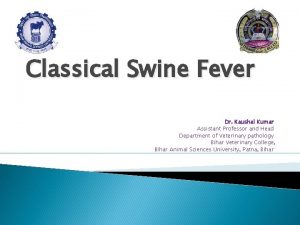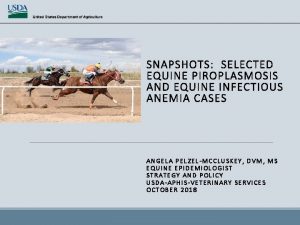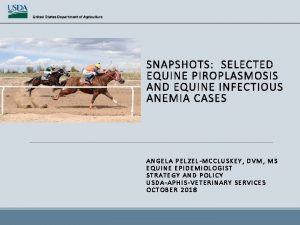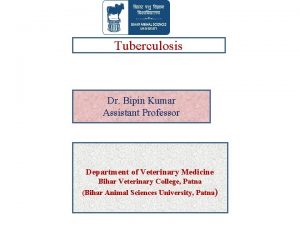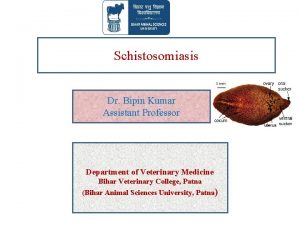PIROPLASMOSIS Kaushal Kumar Assistant Professor Head Department of




































- Slides: 36

PIROPLASMOSIS Kaushal Kumar Assistant Professor & Head Department of Veterinary Pathology Bihar Veterinary College Bihar Animal Sciences University Patna-800014 Image source: Google image

Babesiosis It is caused by a intraerythrocytic protozoan parasites of the genus Babesia. Transmitted by ticks, babesiosis affects a wide range of domestic and wild animals and occasionally people. v Babesia parasite has been observed first time by Babes in 1888 from blood of African cattle.

Babesiosis Babesia species caused diseases are known as • Babesiosis • Red water disease • Texas fever • Biliary fever • Piroplasmosis • Spleenic fever • Tick fever • and • Nantucket fever.

Babesiosis-Etiology v Babesia spp. are found single as round, oval or amoeboid trophozoite or in pairs as pyriform (Pear shaped) merozoites inside the R. B. C. v Infective stage is sporozoites which inoculated into host during blood Image source: Google image sucking of tick.

Genus: Babesia v Different species of Babesia found in Cattle & Buffalo : Species Definitive host Vector Babesia bigemina Cattle and buffalo Boophilus microplus ( India), B. annulatus Babesia bovis Cattle, and buffalo -do- Babesia divergens Cattle - do- Babesia major Cattle Haemaphysalis punctata

Babesiosis v Different species of Babesia found in dog & cat : Species Definitive host Vector Babesia canis, Dog Rhipicephalus sanguineus Babesia gibsoni Babesia cati Dog Rhipicephalus sanguineus Babesia felis Cat Rhipicephalus , Dermacentor etc.

Babesiosis-Transmission v It is tick (hard tick) transmitted parasites. v In 1893, Smith and Kilborne first discovered that transmission of Babesia bigemina by the Boophilus annulatus tick.

Genus: Babesia Transmission : ü When Babesia spp. are transmitted through the ovary (egg) for two or more generation of one host female ticks called transovarian transmission. e. g. Babesia bigemina. ü When infection persists from one stage to the next stage in 2 or 3 host ticks feeding on different hosts, transmission is said to be transtadial. Larva Nymph Adult

Babesiosis Transmission : Image source: Google image

Babesiosis-Transmission Vector: - transmitted by hard ticks. Image source: Google image

Life-cycle of Babesia spp. o Sporozoites inoculated in to hosts by the infected tick during blood sucking. o Sporozoites enter inside RBCs and converted into Trophozoites. o Trohozoites multiply by binary fission and form merozoites. o Merozoites form gamonts inside RBCs. o Gamonts come into gut lumen of ticks during blood sucking of infected hosts.

Babesiosis Pathogenesis : Depends upon some factors likes o Species of the Babesia : - B. bovis, B. canis and B. motasi are highly pathogenic than other species of their hosts. o Age of the host – An inverse age resistance is found in Babesia infection i. e. older animals are more susceptible to babesiosis in comparison to younger animals. o Breed of the host, Immune status of host, stress etc.

Babesiosis Pathogenesis : o Main pathogenesis is intravascular haemolysis which is due to rapid multiplication of Babesia inside the RBCs followed by destruction of the RBCs. o Extravascular haemolysis which mostly occurs in the spleen, due to phagocytosis of infected and noninfected RBCs by the activated macrophage.

Babesiosis Pathogenesis : o Intra and extravascular haemolysis may cause haemoglobinuria, haemoglobinaemia, bilirubinuria and anaemia with further consequences of tissue hypoxia, metabolic acidosis, hyperkalaemia, hypovolaemic shock and development of multiple organs dysfunction leading to death of the infected host.

Babesiosis Symptoms: Ø High fever (1060 F) Ø Coffee colour Urine-Haemoglobinurea. (red water disease) Ø Hemoglobinemia /Anaemia Ø Pale mucous membrane (Jaundice) Ø Pipe-stem diarrhea Ø Hepatomegaly and splenomegaly Ø Death in untreated case. Image source: Google image

Babesosis o Young calves are generally immune due to maternal antibodies received from the mother through the colostrums. o Babesiosis mostly occurs in cattle than buffalo. o Cerebral babesiosis occurs in cattle due to Babesia bovis infection in which blockage of cerebellum capillaries takes place due to clumping of infected RBCs. The resulting symptoms are ataxia, anoxia, paddling of limbs, convulsion and coma. o In Babesia sp. infection, immunity is premunity i. e. the animals recovered from the clinical infection may continue to harbour organisms and remain immune to reinfection.

Diagnosis of Babesiosis 1. On the basis of cardinal clinical sign ( fever, coffee coloured urine etc. ) and necropsy findings (hepatomegaly, splenomegaly , etc) 2. Microscopic examination of blood smear- During fever Giemsa/Leishman stained blood smear will show Babesia organism mostly in pairs inside the RBCs. 4. By serological test like CFT, IFA, ELISA etc. 5. Molecular test- Polymerase chain reaction (PCR). Image source: Google image

Theilerosis o Arnold Theiler (scientist) found that East coast fever was not the same as redwater but caused by a different protozoan. o A group of tick-borne diseases caused by Theileria spp.

ETIOLOGY: Genus: Theileriae are obligate intracellular protozoan parasites phylum: Apicomplexa, order: Piroplasmida, family: Theileriidae, genus : Theileria. They are most closely related to Babesia, from which they differ by having a developmental stage in leukocytes prior to infection of erythrocytes. The most pathogenic and economically important are: 1. 2. T. parva, which causes East Coast fever (ECF), T. annulata, which causes Tropical theileriosis (TT) Image source: Google image

Genus: Theileria Species Theileria annulata Definitive host Cattle and buffalo Vector Disease Hyalomma anatolicum Bovine Tropical theileriosis or Egyptian theileriosis or Mediterranean theileriosis Theileria parva Cattle and buffalo Rhipicephalus appendiculatus Theileria lawrenci Rhipicephalus appendiculatus East coast Fever or January fever Corridor disease Cattle and buffalo

Transmission Vector: Theileria species are transmitted by Ixodid ticks. Image source: Google image

Theileriosis Transmission : o Transtadial or stage to stage transmission found in Theileria spp. o When parasite enter in one stage of tick (larva or nymph) during feeding on an infected animal. Then, the subsequent stage (nymph or adult) of tick transmit the disease during feeding on a susceptible hosts. o Larva nymph adult o • Theileria parasites are most commonly transmitted when ticks feed on infected animals as nymphs and then on susceptible cattle as adults. Image source: Google image

Theileriosis Transmission : o Infective stage is sporozoites which inoculated into final host during blood sucking of infected tick.

Life-cycle of Theileria Image source: Google image

Theileriosis Pathogenesis : Ø T. annulata occurs in India and more pathogenic in case of cross-bred and exotic cattle. ØBuffaloes are also infected by this parasite but infection is remain asymptomatic.

Pathogenesis : Theileriosis o Macroschoizonts (Koch’s blue bodies) stage initially lead to increased infected lymphoblast population and later lymphocytosis and leucopenia. o Piroplasmic stage responsible for erythrophagocytosis by macrophages resulting to development of anaemia. Image source: Google image

Theleriosis Symptoms: o o o High fever Enlargement of superficial lymph nodes (prescapular lymph nodes). Unwillingness to feed and drink Cessation of rumination, drop milk production, lacrimation, nasal discharge, anaemia etc. Haemorrhagic diarrhoea and death due to dysponea as a result of oedema in the lungs.

East Coast fever • An acute disease of cattle, is usually characterized by high fever, swelling of the lymph nodes, dyspnea and high mortality. • Caused by Theileria parva, and transmitted by the tick vector Rhipicephalus appendiculatus. • it is a serious problem in east and southern Africa.

Tropical Theileriosis • Caused by Theileria annulata, and transmitted by the tick vector Hyalomma anatolicum • The kinetics of infection and the main clinical findings are similar to those produced by T parva, but unlike in East Coast fever, anemia is often a feature of the disease. • Characteristic signs include fever, swollen superficial lymph nodes & Corneal opacity.

Theileriosis Symptoms: Corneal opacity in Theileria annulata infected calf. Image source: Google image

Theileriosis Post-mortem lesions : Necrotic punched ulcers in the abomasums are characteristic post-mortem finding. o Generalized enlargement of lymph nodes, hepatomegaly and splenomegaly. o Necrotic punched ulcers Image source: Google image

Diagnosis of Theileria 1. On the basis of cardinal clinical sign ( high fever, Enlargement of superficial lymph nodes etc. ) Image source: Google image

Diagnosis of Theileria o Microscopic examination Peripheral blood sample of blood should be smearcollected from the suspected animals at the of pyrexia. Giemsa/Leishman stained blood smear will show annular (ring shaped) piroplasm stage of Theileria organism mostly single inside the RBCs. Piroplasm stage of T. annulata (Ring shaped) Image source: Google image

Diagnosis of Theileria o Lymph gland Biopsy smear – Lymph fluid aspirate from the infected lymph glands, then lymph smear prepared and stained with Giemsa stained revealed macroschizonts stage ( Koch’s blue bodies) inside the cytoplasm of Lymphocytes. Koch’s blue bodies o Serological test like CFT, IFA, ELISA etc. o Molecular test- Polymerase chain reaction (PCR) etc. Image source: Google image

Theileria equi • In case of Theileria equi, sporozoites invade the lymphocytes and after development form Theileria-like schizonts in lymphocytes. The merozoites released from these schizonts invade red blood cells (RBCs) and transform into trophozoites which grow and divide into pear-shaped tetrad (‘Maltese cross’) Maltese cross Image source: Google image merozoites.

Thanks
 Akshay kumar assistant
Akshay kumar assistant Cuhk salary scale 2020
Cuhk salary scale 2020 Promotion from assistant to associate professor
Promotion from assistant to associate professor Surbhi kaushal
Surbhi kaushal Jyoti kaushal
Jyoti kaushal Rainu kaushal
Rainu kaushal Dr kaushal agrawal
Dr kaushal agrawal Kaushal bharat helpdesk
Kaushal bharat helpdesk Manifesto for head prefect
Manifesto for head prefect Hod roles and responsibilities
Hod roles and responsibilities Html tagi
Html tagi Patientsite com
Patientsite com The head of moving head disk
The head of moving head disk What is tone unit
What is tone unit Dividing head calculation formula
Dividing head calculation formula Tonic syllable
Tonic syllable Shin body part
Shin body part The head of moving head disk with 100 tracks
The head of moving head disk with 100 tracks The attacking firm goes head-to-head with its competitor.
The attacking firm goes head-to-head with its competitor. Positive suction head and negative suction head
Positive suction head and negative suction head Hamiltonian formulation of general relativity
Hamiltonian formulation of general relativity Dr anuj kumar tripathi neurosurgeon
Dr anuj kumar tripathi neurosurgeon Pyelomyotomy
Pyelomyotomy Where are amu and kumar travelling through
Where are amu and kumar travelling through Bedford interview skills
Bedford interview skills Nirman kumar
Nirman kumar Xshhz
Xshhz Kumar
Kumar Ifcsi
Ifcsi Jay kumar kar
Jay kumar kar Kumar
Kumar Customer relationship management kumar
Customer relationship management kumar 2 finger pincer grasp
2 finger pincer grasp Kumar
Kumar Ravi kumar kopparapu
Ravi kumar kopparapu Pavan kumar vijay
Pavan kumar vijay Mahendra kumar fiji
Mahendra kumar fiji








































